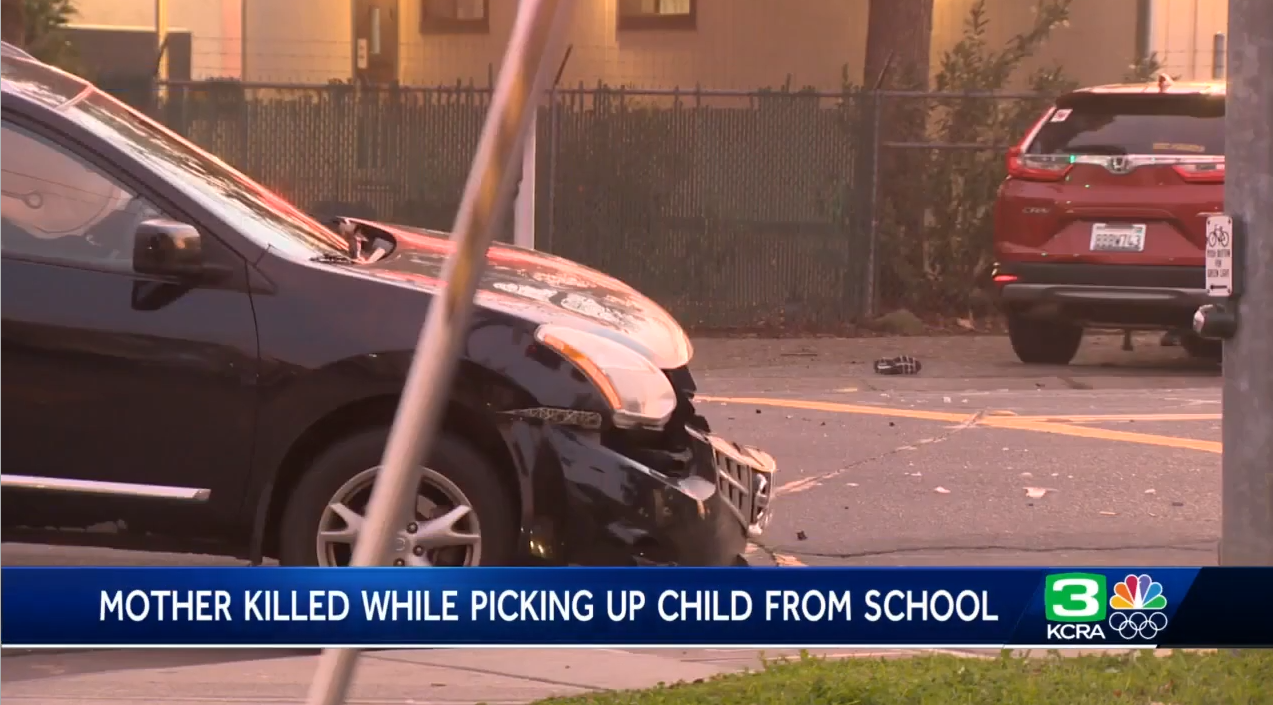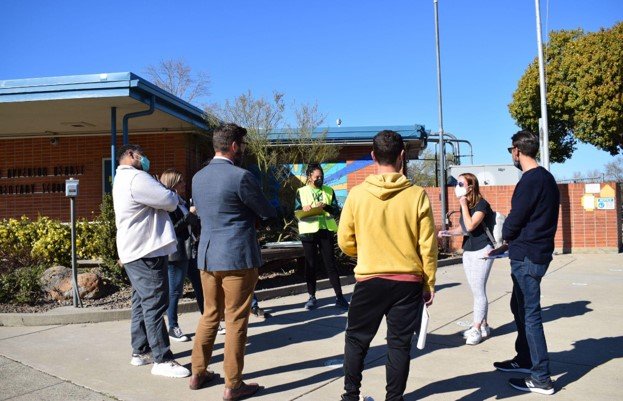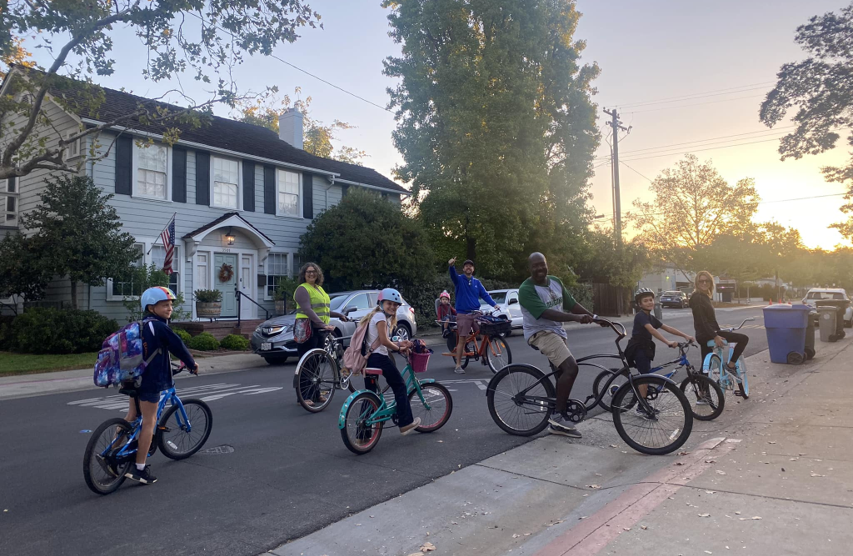This story was first published at Strong Towns at this link.
In January 2022, a tragic event in front of my children’s elementary school incited a deep resolve within me and many others in my community. A mother, awaiting her daughter, was killed while standing on the curb, the victim of a violent crash caused by a red-light runner. This incident sparked a new direction in my life's journey as a community advocate, instigating a commitment to make this legacy arterial road safer for its most vulnerable users.

This story unfolds around Phoebe Hearst Elementary in Sacramento, California. A multi-year recipient of the California Distinguished School Award from the California Department of Education, this highly coveted learning institution attracts parents citywide who submit their children to placement testing and a lottery for enrollment. Unique in our district, Phoebe Hearst is a 100 percent open enrollment elementary school, drawing students from all across the city to its campus each day.
Situated amidst residential, commercial, and educational corridors, the school was initially constructed in 1959, with then-Highway 50 bordering its southern edge. In 1970, the interstate was widened and realigned 1,500 feet south. This realignment left a large east–west stroad cutting through many communities, creating conditions for unsafe speeding through several neighborhoods and commercial corridors, including around Phoebe Hearst.

Over the past few decades, the city of Sacramento began acknowledging the challenges created by this high-speed stroad, an artifact from a bygone era designed for a different purpose. Traffic calming measures were installed on Folsom Boulevard, such as reducing the four-lane arterial to a two-lane road with bike lanes and proper turning medians, slowing traffic and improving safety. Initially skeptical residents came to appreciate the calmer traffic patterns and reduced road noise brought about by these design changes.
However, as too often happens, there were gaps in these safety upgrades. The measures were implemented on Folsom Boulevard in a piecemeal manner as funding became available, either through grants or from impact fees collected from adjacent development. Between 59th and 65th streets, where Phoebe Hearst is located, the road remained a four-lane arterial, often the site of motor vehicles traveling in excess of 50 miles per hour in a 25-mile-per-hour school zone.

In 2015, the city of Sacramento conducted a study that recommended transforming the dangerous four-lane stroad into a two-lane street, mirroring the successful changes enacted west of the campus. Regrettably, due to the city's backlog of over 700 unfunded transportation projects with estimated costs of $5 billion, the study collected dust on a shelf over the subsequent years. Meanwhile, Phoebe Hearst's open enrollment policy continued drawing more students citywide, escalating the daily commuter traffic, especially during afternoon pick-up and morning drop-off times.
January 13, 2022, is a day I will never forget. Lupe Jimenez, a parent and member of our school community, was standing at the corner of 60th and Folsom Boulevard, waiting for her 6th-grade daughter to be dismissed from school. For reasons we may never fully understand, a car ran a red light, causing a violent collision with another vehicle at that intersection. One of the cars came to rest on the easement where Lupe was standing, striking her. Other parents, also waiting for their children, rushed to her aid, attempting to lift the car off Lupe before the paramedics arrived. Their efforts were in vain; Lupe succumbed to her extensive injuries.

In the aftermath of the crash, I found myself besieged by a whirlwind of emotions: grief for the loss of a parent, regret that more wasn't done to prevent this tragedy, anger at the inconsiderate speeders who race past the school every day, and helplessness knowing that the conditions leading to this calamity would persist. Reflecting on my role as a volunteer crossing guard at the school's crosswalk, I acknowledged the stark contrast between the available traffic data suggesting the stroad was safe and the reality of near misses, screeching brakes, and minor, unreported fender-benders I had witnessed regularly. I felt an overpowering urgency to prevent another needless tragedy.
Following Lupe's death, another parent and I, both politically savvy and resolute, began meeting with our school principal to form a Traffic Safety Committee. In mourning but driven, we were determined to discourage parents from parking on Folsom Boulevard, urging them to use the quieter residential neighborhood surrounding the school instead. Simultaneously, we acknowledged that long-term solutions required significant changes to the built environment, necessitating funding and political will. Over time, our committee expanded, attracting members with diverse skills and connections, all united in the common goal of making our school and streets safer for vulnerable users, especially our students, parents, and staff.

We arranged a virtual town hall meeting, allowing officials to explain their plans and providing parents with a platform to voice their concerns. Our aim was to hold our elected leaders accountable, ensuring their commitment to addressing the stroad's problems and keeping the issue at the forefront. We refused to let Lupe's memory fade, knowing that in our car-centric city, the need for speed and convenience too often eclipses the safety of our children and community members. We had to make sure this incident wouldn't be dismissed as just another fleeting news item.
Initially stumped by funding, we looked into federal grants, local resources, agency partners, and even our own PTO for small, temporary measures. We explored every potential avenue for funding a road diet plan, refusing to accept the "no money" excuse.
As the months passed, the Traffic Safety Committee kept meeting each week. We organized a bike bus to reduce the number of drivers commuting to school each day. We persuaded the city to install radar speed detection signs and rumble strips to remind motorists they were entering a school zone. Thankfully, parents stopped parking near the location of Lupe’s crash on Folsom Boulevard, which alleviated some of the dread I felt daily during crossing guard duties. But the traffic speeds remained high, and within a few weeks, there was another collision at the same intersection, though fortunately, without injuries.
I felt our momentum slipping, fearing Lupe would become just another name in the long list of vehicular violence victims. Despite my best efforts to keep the story alive in the local media, the response was dishearteningly familiar: “It’s just not news anymore, unless the widower wants to share his story.”

I met Chris Brown, Lupe's widower, only after his wife's death. A few months after Lupe's passing, Chris joined the Traffic Safety Committee, aware that his wife would have wanted her sacrifice to make a difference. Chris was an incredibly brave but private man. In August, about eight months after the crash, I asked him if he would share his story with the media. He agreed and welcomed an investigative reporter into his home. Chris spoke of his grief, his pain, and the anguish of losing his wife. It was heart-wrenching to watch, but it served as a powerful reminder to our community and our elected officials why we refused to give up.
Shortly after Chris's story aired, our State Assembly member, whose children once attended Phoebe Hearst, allocated $5 million in his budget towards fixing Folsom Boulevard. The area's city council member, soon to leave office, found another $1 million. This combined funding, which had previously seemed impossible, meant the long-awaited road diet could finally proceed.
We held a press conference near the crash site, where our assembly member presented a symbolic check. Chris was all smiles, and I felt immense gratitude for being part of this persistent group of advocates who refused to let this incident be just another forgotten and unaddressed pedestrian fatality.
Today, I am pleased to share that the implementation of the road diet plan is in progress. Of course, it's not an overnight process; it requires engineering, surveys, community outreach, and construction. But by fall 2025, we will have a safer Folsom Boulevard, designed to slow motorists and protect our vulnerable community members. It's a much-needed change, and it's happening faster than we could have imagined.

The moral of our story is to never give up. Your community deserves nothing less. While the stakes are high, the potential rewards are even greater. Our journey has shown that activism can bring about real change. We must remember the human stories behind the data and charts. We have the opportunity to reshape our world, creating a safer community where children can attend school without fearing they'll be the next to be struck by a speeding car.
I wish such improvements were the norm, that such a high price didn't need to be paid for safer environments. And I wish Lupe could be here to celebrate our achievements with us.






